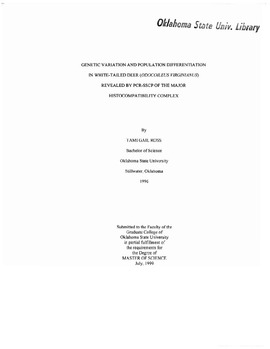| dc.description.abstract | Natural populations are exposed continually to environmental forces and anthropogenic perturbations that may alter their genetic structure and therefore their evolutionary fate. Because MHC class I and II gene products are an important part of the first line of defense in an immune response against foreign pathogens, it has been suggested that MHC differentiation among populations may be a direct reflection of the differing habitats and associated pathogens to which they are exposed. Unfortunately, the role that environmental and human-induced perturbations play in evolution and maintenance of variability at MHC loci, and the levels of MHC variability in natural populations, is poorly understood. to provide baseline data on levels of MHC genetic variation within and among seven populations of white-tailed deer, exon 2 of the class II Mhc-DRB locus was examined via Single-Strand Conformation Polymorphism (SSCP) analysis. This study has documented that although white-tailed deer were virtually extirpated from the eastern United States, high levels of genetic variability remain at the Mhc-DRB locus. If MHC allelic diversity is important for defense against pathogens, white-tailed deer may have survived this bottleneck with sufficient MHC allelic diversity to combat pathogenic invasions. Additionally, although white-tailed deer have been transplanted throughout this region, significant genetic differentiation over macro- and micro-geographic scales provides support for the hypothesis that MHC differentiation is a direct reflection of differing pathogenic environments. | |
